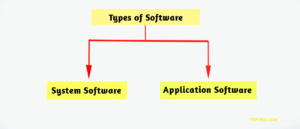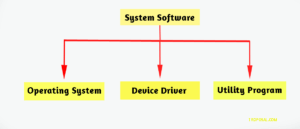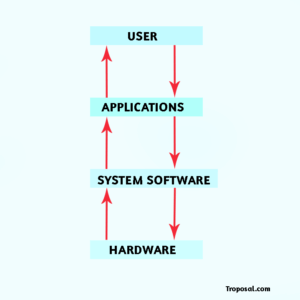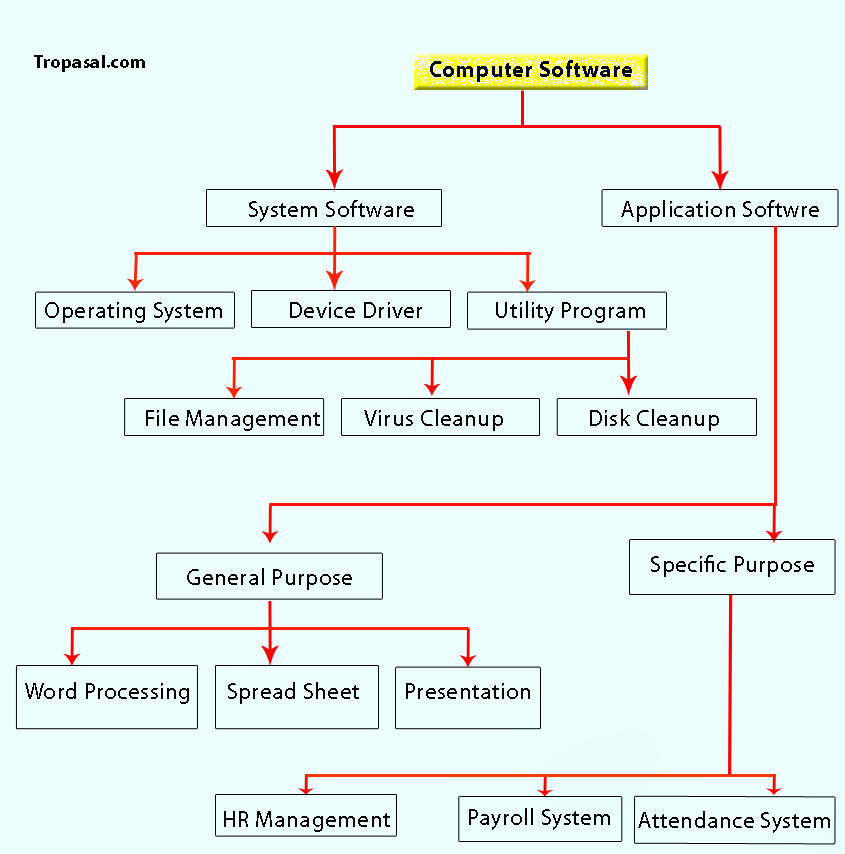Software, also known as a program, consists of a set of related instructions that tell the machine what tasks to perform and how to perform them, structured for a common purpose.
It plays an important role in the computer system by creating a connection between computer hardware and computer users. You interact with software through its user interface. The user interface controls how you enter data and instruction and how the information display on the screen.
Today, software often has a Graphical User Interface (GUI). With a GUI, you interact with the software using text, graphics, and visual images such as an icon.
Software is available a variety of form:
Packaged software: It’s copyrighted software that’s available in computer stores or on the Internet.
Custom software: If you want specific software to suit your needs, you can use programmers to create custom design software for you, which generally cost more than packaged software.
Web application: It is a website that allows users to access software from any computer that is connected to the internet. Types of web applications include e-mail, word processing, and game programs, online booking, online money transfer, etc.
Open source: You can use and make changes to open-source software. It can normally be downloaded for free from the internet.
Shareware: It is patented software that has been released free of charge for the trial duration. You must pay the software creator if you choose to use the service after the trial period.
Free ware: It is proprietary software that is distributed free of charge by a person or a corporation that maintains all rights to the software.
Type Of Software

There are several software applications packaged to suit the various needs of the user. It can be classified into two main types:
System Software
The system software is computer software designed to operate computer hardware and to provide and maintain an application software platform. It helps to run your computer hardware and your computer system.
The user does not communicate directly with the hardware of the computer. Instead, the system software is the interface between the user, the application software, and the hardware such as printers, scanners, monitors, keyboards, etc.
For example, when the user instructs the application software to print a document, the application software sends the printing instructions to the system software, which then sends the printing instructions to the hardware.
Types of System Software:

Operating System

An operating system or OS is a software program that allows computer hardware to communicate with and operate with computer software.
The operating system recognizes input from an input device such as a keyboard, mouse, microphone, or PC camera, coordinates the output display on the monitor, instructs the printer how and when to print information, and handles data and instructions in the memory and information stored on the disc. The operating system is stored on your computer’s hard disc.
The function of an operating system:
There are many different operating systems that have designed for all types of computers, and all of them have similar functions that include:
- Each time you start the computer, the computer loads the operating system (OS) into the computer’s memory so that it can be used. This process is called booting.
- The operating system allows you to give orders to the system. When you delete old documents or move a file from one folder to another, you are using the operating system.
- You use the operating system to tell the computer to run the software, such as a word processing or a graphical program.
- The operating system works as an interface or as a bridge between the user and the computer hardware. Based on the interface, the operating system is divided into two categories: the command-line interface and the graphical user interface.
- Command-line interface: In a command-line interface, type keywords or press special keys as a keyboard command to enter data and instructions. The instruction set you use to communicate with your computer is called the command language. The command-line interface is also difficult to use because it requires accurate spelling, syntax, and punctuation. Minor errors, such as missed time, can produce an error code.
- Graphical user interface: As a graphical user interface does not need you to memorize the command language, it is easier to understand and use the command-line interface.
The Graphic User Interface (GUI) allows you to allocate command to a graphic object.
Categories of Operating system
The operating system normally comes pre-loaded to the machine you’re purchasing today. But it’s possible to update or even change the operating system to suit your needs. The three basic types of operating systems are stand-alone, server, and embedded.
Stand-alone operating system
A computer operating system that runs on a desktop computer, a laptop computer, or a handheld computer is called a stand-alone operating system.
Some stand-alone operating systems are referred to as client operating systems. The operating system of the client may run with or without a network. Examples of current stand-alone operating systems are Microsoft Windows, Mac Os, and Linux.
Microsoft Windows: Microsoft has developed a Windows operating system that has a graphical user interface. Some of the popular Windows operating systems are Windows 3.1, Windows 95, Windows 98, Windows 2000, Windows NT, Windows ME, Windows XP, Windows Vista, Windows 7 and Windows 8, Windows 8.1, and Windows 10.
Mac Os: It is a series of graphical user interface-based operating systems developed by Apple Inc. for their Macintosh line of a computer system.
Linux: It is an operating system that is available free of charge on the Internet. Linux is an open-source operating system. It can be copied and modified.
Server operating system
The server operating system is an operating system specifically designed to support the network. The server operating system usually resides on the server. The client computers on the network rely on the server (S) for resources. Examples of server operating systems include windows server, UNIX, Solaris, and Netware.
Embedded Operating System
An embedded operating system uses on mobile devices and a wide variety of consumer electronics. It resides on a ROM chip, popular embedded operating systems today include windows embedded CE, windows mobile Plam OS, iPhone OS, BlackBerry, Google Android, Windows mobile, and Symbian OS.
Device drivers
The device driver, also known as the driver, is a small program that tells the operating system how to communicate with the device. It acts as a “link” between the hardware on the computer system and the OS.
The operating system relies on device drivers to communicate with each device on the computer. Each device on a computer, such as a mouse, keyboard, etc., has its own specific set of commands and thus needs its own particular drivers. When you boot a computer, the operating
system loads the driver of each device. Without their correct drivers, these devices will not work.
Utility software
The utility program is the type of system software that performs a specific task, usually related to the management of a computer, its devices, or its program. It’s also called a utility. It helps with the management of computer hardware and application software. The typical example for utility software:
- File Management: A utility that performs by viewing a list of files on a storage medium, arranging files in a folder, copying, renaming, deleting, moving and sorting files and folders, and creating shortcuts, is called file management.
- Virus Cleanup: Protects your computer from viruses by detecting and removing any viruses contained in the memory, storage media, or incoming files. Some of the popular virus scanner programs are McAfee Virusscan, Norton Antivirus, etc.
- Disk Cleanup: It is a window utility that scans for and removes unwanted files. Unnecessary files can contain the downloaded program files. Temporary files on the Internet, lost files, and unused program files.
Application software
Application software consists of a program designed to make users more efficient and assist them with personal documents, create multimedia presentations, design web pages, and diagrams, draw pictures, capture and improve audio and video recordings, write e-mail messages and instant messages, and more.
To achieve these and several other activities, user work with application software is classified as a general purpose and a specific purpose.
General Purpose
Many people have similar activities and their computing needs are common. For example, all shopkeepers would need the same computer software for their sales, inventory, storage, and staff. There are thousands of shopkeepers all over the world. As a result, standard applications can be built for shopkeepers so that they can perform their general purpose tasks.
This software is available in a CD-ROM or a DVD. You may buy this program from the related vendors in retail stores or on the Internet. Examples of general-purpose applications include word processing, spreadsheet, presentation, and database management.
Word processing software
Word processing is the ability to create a document by using a word processor. A word processor is just like a digital typewriter. You use it to build and update a document such as the latter. Reports, articles, etc. have been replaced by electronic typewriters in most offices, as a document can be quickly edited, checked, and reprinted. Microsoft Word is a widely used word processing program.
Spreadsheet software
With the help of spreadsheet software, you can handle personal and business finances. You can use the spreadsheet program to calculate, analyze, and present information. The most widely used spreadsheet is Microsoft Excel.
Database software
A database is a collection of related information or records on any subject, such as a record of books in a library, information about students in a school, etc. Database software enables you to create, access, and maintain a database. The most commonly used database software for Microsoft Access.
Presentation software
Presentation software helps you to create documents called presentations that are used to share concepts, messages, and other information to a group. The presentation can be presented as slides, often known as slideshows. One of the most popular graphics presentation tools in Microsoft PowerPoint.
Specific Purpose
Special purpose application software is a type of software designed to perform a particular task. A web browser, for example. The basic aim of a web browser is to show you the websites and to make it easier for you to surf the internet.
Sometimes, the need of the business is so specific that there isn’t any ready-made solution available in the market or on the internet. So to get a specialized solution, a business has to get fresh specific software developed for their needs. The main advantages of this software are that they work exactly as we want as if these are designed according to our needs. Example of specific purpose software are:
Accounting management
The accounting management uses to fulfill the needs of the company’s finance department by carrying out accounting operations related to general accounts receivable, accounts payable, sales, invoices, labor costs, and payroll functions.
Reservations system
The reservation system uses for online bookings. These bookings may be for train, airplane, hotel rooms, holiday packages or any other sort of performance, and much more.
HR management
HR management software centrally maintains employee information such as contact details, job status, benefits details, full dependent information, compensation, performance evaluations, payroll, training, and more. It also monitors and reports on participation, employees’ requests for benefits, accidents, and training to meet government reporting standards.
Attendance system
The attendance systems use by companies of all sizes to keep track of employees, mainly in order to pay their salaries. This method also details such as the arrival and departure of workers, since certain businesses are forced to document the number of hours spent on particular tasks in order to cost jobs accurately. This is referred to as costing jobs.
Payroll system
Payroll software used a computer to calculate the salary, bonus, commission, overtime, double-time, etc. for each employee with accuracy by eliminating time-consuming and error=prone manual processes. The payroll system issued a printed payslip and records the information about the amount paid to each employee for accounting purposes.
Inventory control system
The Inventory Management System is a mechanism to track and locate the number of goods in a shop. The main function of the inventory system is to keep track of the item in stock. It also displays the item that has been sold and needs to be re-ordered in order to keep the item in the shop. The inventory system also assesses increasing products are more in demand and needed on the market and which item is less in demand on the market.
Memory bytes
- Software, also called a program, consists of a series related instruction, organized for a common purpose, that tells the computer what tasks to perform and how to perform.
- The system software is computer software designed to control computer hardware and to establish and manage an application software infrastructure.
- An operating system or OS is a software program that allows the computer hardware to communicate and operate with computer software.
- Application software consists of programs designed to make users more productive and assist them with their personal tasks.
- Special purpose application software is a type of software that has created to execute a specific task.
You may take a Computer Software quiz based on Computer Software – Definition and Types article

